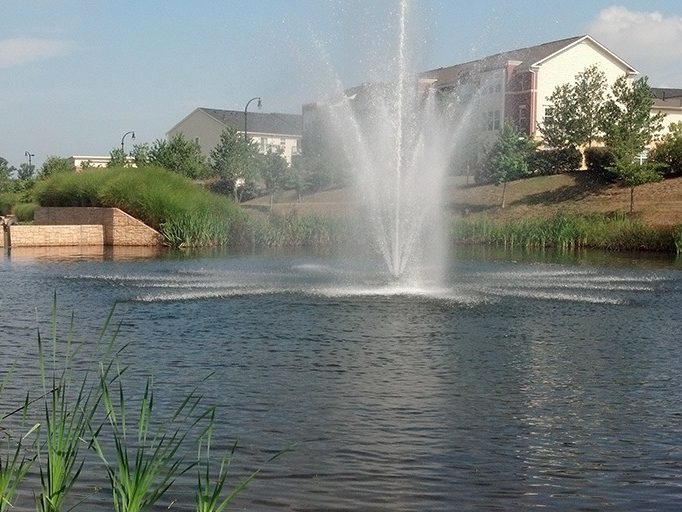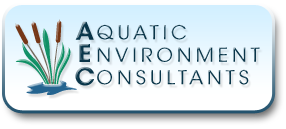

Lake and Pond Algae Control
Plants and algae are essential to the health of any lake or pond, but when their growth gets out of control, they can have a number of negative effects.
Lake algae control is an essential part of aquatic management — knowing which algae are good and which are bad, and when intervention is necessary, will help keep your lake or pond attractive, clean and healthy.
Since 1987, Aquatic Environment Consultants (AEC) has specialized in pond algae bloom control and management for clients throughout the Midwest and Mid-Atlantic regions. We can provide both ongoing maintenance and emergency interventions for all types of algae issues. Read further for additional information about pond and lake algae control, and call us at 717-264-9778 for a consultation when you’re ready to take the next step toward a beautiful, healthy body of water.
What to Know About Algae
Algae can be found in almost all lakes, ponds and other freshwater sources. They are a naturally occurring part of the ecosystem and serve a number of important functions; including preventing erosion, absorbing carbon dioxide and serving as food for certain species of fish.
Algae are typically classified into one of three categories:
- Planktonic — At healthy levels, planktonic algae can only be seen under the microscope, and they do not harm the overall aquatic health or water quality of your pond or lake. When its growth gets out of control, however, it can quickly overwhelm a pond or lake. This results in large “blooms” in which a thick layer of green scum appears on the water’s surface, creating an unattractive appearance and disrupting the body’s ecosystem. The combination of a certain temperature and nutrient level can cause overgrowth.
- Filamentous — Filamentous algae, also known as “pond scum,” can be seen on rocks, logs, docks and other underwater surfaces. When growth is excessive, it creates large green mats that float on the surface of the water. As opposed to planktonic algae, filamentous algae are longer and more thread-like. Filamentous algae are prone to grow in excess if phosphorus and nitrogen are abundant in the lake or pond, and different types can have a slimy, cottony or coarse, horsehair-like texture.
- Macrophytic — Although it’s plant-like in appearance, macrophytic algae — commonly called chara, stonewort or muskweed — is actually part of the algae family and must be treated as such. Chara can be found growing on the bottom of most lakes and ponds. It’s easily identifiable thanks to its forked leaves, coarse texture and strong musky smell. These organisms are an important component in a body of water’s ecosystem at normal levels, providing food and shelter for wildlife. They only cause problems when growth is too heavy.
Why Controlling Pond Algae Is Important
Algae control in lakes and ponds is an important part of aquatic maintenance. Too much algae can lead to:
- poor tasting, foul-smelling drinking water
- unpleasant recreational activities, such as swimming and fishing
- a disrupted ecosystem, which limits the amount of sunlight penetration and the rate of oxygen production (this can affect fish populations)
- the growth of cyanobacteria (called blue-green algae), which may contain toxins that are hazardous to pets and wildlife and can cause illness in humans
What Causes Algae in Lakes and Ponds?
When it comes to proper pond and lake algae control, it’s important to first understand the factors that come into play when algal growth is excessive . To stay ahead of the problem and avoid excessive algae growth, knowing what to monitor is half the battle. Every body of water is unique, and no single answer fits every situation. The experienced technicians at AEC have the knowledge, training and backgrounds to accurately identify and monitor the circumstances affecting algae behavior in your lake or pond.
Some factors to consider include:
- Water nutrient levels: Phosphorus and nitrogen in lake and pond water are the diet of blue-green algae. These nutrients are found naturally in water, but chemical runoff and erosion also introduce them. Poor sewage management, fertilizers and other external circumstances can increase nutrient levels to the point that algae grows out of control. It’s even possible for water bodies to build up an internal supply of excess nutrients on their own.
- Light exposure: Algae need the perfect amount of light to thrive. Blue-green algae can move throughout water columns and adapt to variable conditions, which makes them extremely common. Filamentous algae, on the other hand, typically grows along shorelines where there is shallower water because there is more sunlight.
- Water temperature: Several factors affect water temperature throughout each day, but it’s important to understand that the warmer your lake or pond water is, the more easily and quickly algae can grow.
- Turbidity: It’s normal for the presence of tiny particles to cloud your view when you’re swimming in any natural body of water. Sediment from the bottom of a lake or pond can be stirred up from water movement, fish activity, high winds and other external circumstances. High turbidity changes light exposure and raises water temperatures, which affects algal growth.
Algae Control for Ponds and Lakes
Several methods have proven effective in planktonic, filamentous, macrophytic, and blue-green algae control in lakes and ponds:
- Mechanical controls —Algae control in small ponds can be accomplished with mechanical controls, such as the use of rakes, seines, screens and other devices. The process is useful for quick remediation of invasive or harmful growth, but it doesn’t usually solve the underlying problem on its own. Typically, this is completed as a quick intervention in conjunction with other management techniques that address the root of the problem.
- Biological controls — Certain fish and insect species can be used to control algae growth. By carefully introducing these animals into a lake or pond ecosystem, it can be possible to restore algae growth to acceptable levels over time.
- Physical controls — Certain physical characteristics like light, aeration and nutrient content make ponds and lakes more conducive to algae growth. By adding a diffuser system or other device that promotes aeration, pond water remains oxygenated which can help keep algae growth in check.
- Herbicides and algaecides — The use of algaecides to control algae is a very effective management strategy. Herbicides and algaecides can quickly kill excessive growth, bringing water bodies back into a healthy balance.
Aquatic Vegetation and Algae Management From AEC
While not the same as overactive algal growth, overabundant vegetation like aquatic flora can have exactly the same negative effects on lakes and ponds. The issue can be unsightly and disrupt the delicate ecosystem balance and overall oxygen production. Without proper aquatic vegetation management, fish populations can be at risk and other aspects of the waterbody may be negatively impacted .
When you contact us for services, we’ll start with a consultation — our experienced technicians will perform a visual survey of your property to assess size, geography, environment and other biological and physical factors. Then, they’ll identify and eliminate current concerns to bring your water quality to a healthy baseline. One-time steps are taken, then we determine specific factors for your unique body of water that we need to test and monitor for over time.
By monitoring algae levels over time, it’s possible to make minor adjustments that will prevent algae blooms and avoid the need for drastic interventions. AEC offers algae monitoring services as part of an overall strategy for safeguarding the health of your lake or pond. Find out more by contacting our team today to arrange your initial consultation.


